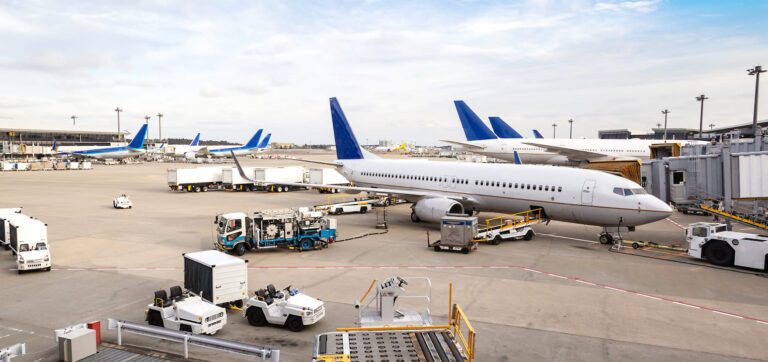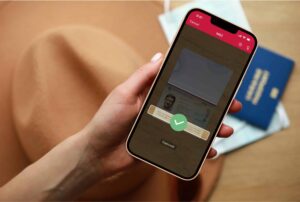With airlines and airports recovering from the effects of the COVID-19 pandemic, there is a need to align cost-efficient processes with high levels of passenger satisfaction. This means tackling three crucial bottlenecks in operations:
- Check-in
- Baggage processing
- Boarding
All of these involve scanning: of boarding passes, passports, or ID cards to identify passengers, and of barcodes to track their luggage. This has traditionally been handled by stationary hardware. How many passengers can be processed in any given timeframe is therefore limited by the number of scanning terminals installed at an airport.
An application with scanning capabilities solves this problem, as it can be installed on as many smartphones or tablets as necessary. This ensures smooth operations, especially during peak times.
Barcode and document scanning functionalities can be integrated into a single app for all staff members that connects to the main database. This ensures that important information is synchronized and easy to access whenever needed.
Let us take a closer look at how you can use barcode scanning and document scanning to efficiently process baggage tags, boarding passes, and passports.
Streamline baggage handling with a mobile barcode scanner
Accurately reading the barcode tags on baggage items ensures they are properly directed and tracked throughout the airport, on the plane, during layovers, and at the destination.
Traditional barcode scanning devices often have trouble parsing poorly printed, damaged, or worn baggage tags. Mobile barcode scanning software, on the other hand, leverages smartphones’ high-resolution cameras and cutting-edge machine learning technology. This enables it to read barcodes whose data would be irretrievable otherwise.
Smartphones’ mobility, processing power, and large screens make them useful for a wider range of applications, as well.
At the boarding gate, staff can easily check in baggage too large for the cabin, simply by attaching and scanning a barcode tag. When retrieving lost baggage, a barcode scanner with AR capabilities helps staff to quickly identify the correct item: They first enter the luggage ID into the app, then point the camera at the barcode tags until one of them lights up green on their screen.
Since everyone can instantly call up the barcode scanner through their mobile device, the baggage processing speed is limited only by how many staff are available.
💡 After takeoff, flight attendants can use the barcode scanner to streamline onboard catering and in-flight shopping – with real-time updates of the plane’s inventory.
Capture boarding passes and passports instantly wherever you are
Processing travel documents is a crucial part of airport operations. It is also a bottleneck for passenger handling, since the document scanning equipment is only installed at a few fixed locations.
With a mobile app, all airport staff can quickly scan boarding passes and passports to speed up check-in, boarding, and customs.
Reading physical and digital boarding passes
Boarding passes contain a passenger’s flight information, both in plain text and encrypted as a barcode. They can be hard to read for scan terminals: Paper passes are often damaged after being folded or stuffed into hand luggage, whereas digital board passes are typically presented on a brightly lit, reflective screen. Powerful scanning software overcomes these challenges to ensure accurate results.
Extracting personal information from passports and ID cards
International passports and many national ID cards feature a machine-readable zone (MRZ) that contains the passenger’s personal information in a standardized format. Document scanning software equipped with OCR technology extracts this information instantly. This data can then be transmitted directly to a backend database, making it accessible to all staff members who need it.
Airlines can include MRZ scanning in their customer-facing apps to ensure user-friendly online check-ins: Passengers no longer have to manually type in their personal details, which include long document ID numbers. Instead, they just scan the machine-readable zone on their passports or ID cards to transfer the data quickly and reliably. This speeds up check-in and prevents input errors that cause delays and other problems for passengers and staff members.
Mobile scanning: A cost-effective and flexible solution
Airports and airlines can complement their existing scanning infrastructure by integrating mobile barcode, document, and data scanning into their internal apps.
Passenger handling speed is no longer limited by the number of physical scanning terminals. Now, staff can move freely along queues to efficiently process passengers’ documents using their mobile devices.
Instead of using multiple systems and expensive dedicated hardware, airports and airlines can unify their above- and below-the-wing operations in one mobile app and make its features and data available to everyone who needs them. Faulty terminals and peak times no longer result in long delays, as all staff members have the necessary tools to handle passengers.
The Scanbot SDK: Your reliable all-in-one scanning solution
You can integrate the Scanbot SDK into your iOS, Android, Windows, or Web application to turn smartphones and tablets into reliable, easy-to-use mobile scanning devices. With its machine learning capabilities, the SDK delivers fast and accurate scanning results. It scans all common 1D and 2D barcodes, both individually and in batches, and enables you to extract data from almost any ID and travel document.
The SDK scans and extracts data entirely offline – all processing happens on the end user’s device. It never connects to any third-party server, making it a secure mobile data extraction solution.
Ready to integrate our SDK into your mobile apps? Then get a free 7-day trial license now!



